Release Notes for Cisco Secure Firewall ASDM, 7.19(x)
This document contains release information for ASDM Version 7.19(x) for the Secure Firewall ASA series.
Important Notes
-
No support in ASA 9.19(1) and later for the Firepower 4110, 4120, 4140, 4150, and Security Modules SM-24, SM-36, and SM-44 for the Firepower 9300—ASA 9.18(x) is the last supported version.
-
ASDM 7.19(1) requires Oracle Java version 8u261 or later—Before you upgrade to ASDM 7.19, be sure to update Oracle Java (if used) to version 8u261 or later. This version supports TLSv1.3, which is required to upgrade the ASDM Launcher. OpenJRE is not affected.
-
ASDM Upgrade Wizard—Due to an internal change, starting in March 2022 the upgrade wizard will no longer work with pre-ASDM 7.17(1.150) versions. You must manually upgrade to 7.17(1.150) or later to use the wizard.
System Requirements
ASDM requires a computer with a CPU with at least 4 cores. Fewer cores can result in high memory usage.
ASDM Java Requirements
You can install ASDM using Oracle JRE 8.0 (asdm-version.bin) or OpenJRE 1.8.x (asdm-openjre-version.bin).
The Oracle version of ASDM is included in the ASA package; if you want to use the OpenJRE version, you will need to copy it to the ASA and configure the ASA to use that version of ASDM.
 Note |
ASDM is not supported on Linux. |
|
Operating System |
Browser |
Oracle JRE |
OpenJRE |
||||||
|---|---|---|---|---|---|---|---|---|---|
|
Firefox |
Safari |
Chrome |
|||||||
|
Microsoft Windows (English and Japanese):
|
Yes |
No support |
Yes |
8.0 version 8u261 or later |
1.8
|
||||
|
Apple OS X 10.4 and later |
Yes |
Yes |
Yes (64-bit version only) |
8.0 version 8u261 or later |
1.8 |
||||
ASDM Compatibility Notes
The following table lists compatibility caveats for ASDM.
|
Conditions |
Notes |
||
|---|---|---|---|
|
ASDM Launcher compatibility with ASDM version |
"Unable to Launch Device Manager" error message. If you upgrade to a new ASDM version and then get this error, you may need to re-install the latest Launcher.
|
||
|
Windows Active Directory directory access |
In some cases, Active Directory settings for Windows users may restrict access to program file locations needed to successfully launch ASDM on Windows. Access is needed to the following directories:
If your Active Directory is restricting directory access, you need to request access from your Active Directory administrator. |
||
|
Windows 10 |
"This app can't run on your PC" error message. When you install the ASDM Launcher, Windows 10 might replace the ASDM shortcut target with the Windows Scripting Host path, which causes this error. To fix the shortcut target:
|
||
|
OS X |
On OS X, you may be prompted to install Java the first time you run ASDM; follow the prompts as necessary. ASDM will launch after the installation completes. |
||
|
OS X 10.8 and later |
You need to allow ASDM to run because it is not signed with an Apple Developer ID. If you do not change your security preferences, you see an error screen. 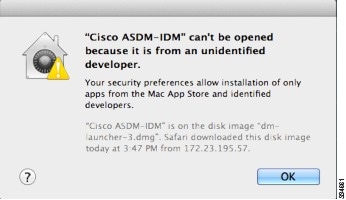
|
||
|
(ASA 5500 and ISA 3000) Requires Strong Encryption license (3DES/AES) on ASA
|
ASDM requires an SSL connection to the ASA. You can request a 3DES PAK license from Cisco:
|
||
|
When the ASA uses a self-signed certificate or an untrusted certificate, Firefox and Safari are unable to add security exceptions when browsing using HTTPS over IPv6. See https://bugzilla.mozilla.org/show_bug.cgi?id=633001. This caveat affects all SSL connections originating from Firefox or Safari to the ASA (including ASDM connections). To avoid this caveat, configure a proper certificate for the ASA that is issued by a trusted certificate authority. |
||
|
If you change the SSL encryption on the ASA to exclude both RC4-MD5 and RC4-SHA1 algorithms (these algorithms are enabled by default), then Chrome cannot launch ASDM due to the Chrome “SSL false start” feature. We suggest re-enabling one of these algorithms (see the pane); or you can disable SSL false start in Chrome using the --disable-ssl-false-start flag according to Run Chromium with flags. |
Install an Identity Certificate for ASDM
When using Java 7 update 51 and later, the ASDM Launcher requires a trusted certificate. An easy approach to fulfill the certificate requirements is to install a self-signed identity certificate.
See Install an Identity Certificate for ASDM to install a self-signed identity certificate on the ASA for use with ASDM, and to register the certificate with Java.
Increase the ASDM Configuration Memory
ASDM supports a maximum configuration size of 512 KB. If you exceed this amount you may experience performance issues. For example, when you load the configuration, the status dialog box shows the percentage of the configuration that is complete, yet with large configurations it stops incrementing and appears to suspend operation, even though ASDM might still be processing the configuration. If this situation occurs, we recommend that you consider increasing the ASDM system heap memory. To confirm that you are experiencing memory exhaustion, monitor the Java console for the "java.lang.OutOfMemoryError" message.
In addition, we recommend reducing your configuration size if possible, for example, by removing unused objects.
Increase the ASDM Configuration Memory in Windows
To increase the ASDM heap memory size, edit the run.bat file by performing the following procedure.
Procedure
|
Step 1 |
Go to the ASDM installation directory, for example C:\Program Files (x86)\Cisco Systems\ASDM. |
|
Step 2 |
Edit the run.bat file with any text editor. |
|
Step 3 |
In the line that starts with “start javaw.exe”, change the argument prefixed with “-Xmx” to specify your desired heap size. For example, change it to -Xmx768M for 768 MB or -Xmx1G for 1 GB. For very large configurations, you may need to specify a heap size up to 2 GB. |
|
Step 4 |
Save the run.bat file. |
Increase the ASDM Configuration Memory in Mac OS
To increase the ASDM heap memory size, edit the Info.plist file by performing the following procedure.
Procedure
|
Step 1 |
Right-click the Cisco ASDM-IDM icon, and choose Show Package Contents. |
|
Step 2 |
In the Contents folder, double-click the Info.plist file. If you have Developer tools installed, it opens in the Property List Editor. Otherwise, it opens in TextEdit. |
|
Step 3 |
Under , change the string prefixed with “-Xmx” to specify your desired heap size. For example, change it to -Xmx768M for 768 MB or -Xmx1G for 1 GB. 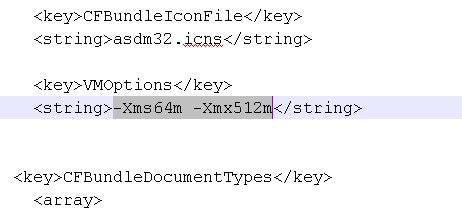 For very large configurations, you may need to specify a heap size up to 2 GB. |
|
Step 4 |
If this file is locked, you see an error such as the following:  |
|
Step 5 |
Click Unlock and save the file. If you do not see the Unlock dialog box, exit the editor, right-click the Cisco ASDM-IDM icon, choose Copy Cisco ASDM-IDM, and paste it to a location where you have write permissions, such as the Desktop. Then change the heap size from this copy. |
ASA and ASDM Compatibility
For information about ASA/ASDM software and hardware requirements and compatibility, including module compatibility, see Cisco Secure Firewall ASA Compatibility.
VPN Compatibility
For VPN compatibility, see Supported VPN Platforms, Cisco ASA 5500 Series.
New Features
This section lists new features for each release.
 Note |
New, changed, and deprecated syslog messages are listed in the syslog message guide. |
New Features in ASDM 7.19(1.95)
Released: July 5, 2023
There are no new features in this release.
New Features in ASDM 7.19(1.90)
Released: February 16, 2023
There are no new features in this release.
New Features in ASA 9.19(1)/ASDM 7.19(1)
Released: November 29, 2022
|
Feature |
Description |
|---|---|
|
Platform Features |
|
|
Secure Firewall 3105 |
We introduced the ASA for the Secure Firewall 3105. |
|
ASA virtual Auto Scale solution with Azure Gateway Load Balancer |
You can now deploy the ASA virtual Auto Scale Solution with Gateway Load Balancer on Microsoft Azure. See the Interfaces features for more information. |
|
Firewall Features |
|
|
Network service groups support |
You can now define a maximum of 1024 network service groups. |
|
High Availability and Scalability Features |
|
|
Removal of biased language |
Commands, command output, and syslog messages that contained the terms "Master" and "Slave" have been changed to "Control" and "Data." New/Modified commands: cluster control-node , enable as-data-node , prompt , show cluster history , show cluster info |
|
ASA virtual Amazon Web Services (AWS) clustering |
The ASA virtual supports Individual interface clustering for up to 16 nodes on AWS. You can use clustering with or without the AWS Gateway Load Balancer. No ASDM support. |
|
Routing Features |
|
|
BGP graceful restart support for IPv6 |
We added BGP graceful restart support for IPv6 address family. New/Modified screens: |
| ASDM support for loopback interfaces for BGP traffic | ASDM now supports setting a loopback interface as the source
interface for BGP neighborship. The loopback interface helps to
overcome path failures.
New/Modified screens: |
|
Interface Features |
|
|
ASA virtual support for IPv6 |
ASAv to support IPv6 network protocol on Private and Public Cloud platforms. Users can now:
|
|
Paired proxy VXLAN for the ASA virtual for the Azure Gateway Load Balancer |
You can configure a paired proxy mode VXLAN interface for the ASA virtual in Azure for use with the Azure Gateway Load Balancer (GWLB). The ASA virtual defines an external interface and an internal interface on a single NIC by utilizing VXLAN segments in a paired proxy. New/Modified commands: external-port, external-segment-id, internal-port, internal-segment-id, proxy paired No ASDM support. |
|
Default Forward Error Correction (FEC) on Secure Firewall 3100 fixed ports changed to cl108-rs from cl74-fc for 25 GB+ SR, CSR, and LR transceivers |
When you set the FEC to Auto on the Secure Firewall 3100 fixed ports, the default type is now set to cl108-rs instead of cl74-fc for 25 GB SR, CSR, and LR transceivers. New/Modified screens: |
|
ASDM support for loopback interfaces |
ASDM now supports loopback interfaces. New/Modified screens: |
|
License Features |
|
|
ASA virtual permanent license reservation support for the ASAv5 on KVM and VMware |
A new command is available that you can execute to override the default PLR license entitlement and request the Cisco Smart Software Manager (SSM) to issue an ASAv5 PLR license when you are deploying ASAv with 2GB RAM on KVM and VMware. You can modify the same command by adding the <no> form to revert the license entitlement from ASAv5 to the default PLR license in correspondence to the RAM configuration. |
|
Administrative, Monitoring, and Troubleshooting Features |
|
|
CiscoSSH stack now default |
The Cisco SSH stack is now used by default. New/Modified screens:
|
|
VPN Features |
|
|
VTI loopback interface support |
You can now set a loopback interface as the source interface for a VTI. Support has also been added to inherit the IP address from a loopback interface instead of a statically configured IP address. The loopback interface helps to overcome path failures. If an interface goes down, you can access all interfaces through the IP address assigned to the loopback interface. New/Modified screens: |
|
Dynamic Virtual Tunnel Interface (dynamic VTI) support |
The ASA is enhanced with dynamic VTI. A single dynamic VTI can replace several static VTI configurations on the hub. You can add new spokes to a hub without changing the hub configuration. Dynamic VTI supports dynamic (DHCP) spokes. New/Modified screens: Configuration > Device Setup > Interface Settings > Interfaces > Add > DVTI Interface |
|
VTI support for EIGRP and OSPF |
EIGRP and OSPFv2/v3 routing is now supported on the Virtual Tunnel Interface. You can now use these routing protocol to share routing information and to route traffic flow through VTI-based VPN tunnel between peers |
|
TLS 1.3 in Remote Access VPN |
You can now use TLS 1.3 to encrypt remote access VPN connections. TLS 1.3 adds support for the following ciphers:
This feature requires Cisco Secure Client, Version 5.0.01242 and above. New/Modified screens: Configuration > Device Management > Advanced > SSL Settings |
|
Dual Stack support for IKEv2 third-party clients |
Secure Firewall ASA now supports dual stack IP request from IKEv2 third-party remote access VPN clients. If the third-party remote access VPN client requests for both IPv4 and IPv6 addresses, ASA can now assign both IP version addresses using multiple traffic selectors. This feature enables third-party remote access VPN clients to send IPv4 and IPv6 data traffic using the single IPsec tunnel. |
|
Traffic selector for static VTI interface |
You can now assign a traffic selector for a static VTI interface. |
|
Specify maximum SSL/TLS protocol version |
You can now specify the maximum SSL/TLS protocol version that the ASA can use when acting as a client or a server. |
Upgrade the Software
This section provides the upgrade path information and a link to complete your upgrade.
Upgrade Link
To complete your upgrade, see the ASA upgrade guide.
Upgrade Path: ASA Appliances
On the Cisco Support & Download site, the suggested release is marked with a gold star. For example:

View Your Current Version
To view your current version and model, use one of the following methods:
-
ASDM: Choose .
-
CLI: Use the show version command.
Upgrade Guidelines
Be sure to check the upgrade guidelines for each release between your starting version and your ending version. You may need to change your configuration before upgrading in some cases, or else you could experience an outage.
For guidance on security issues on the ASA, and which releases contain fixes for each issue, see the ASA Security Advisories.
Upgrade Paths
This table provides upgrade paths for ASA.
 Note |
ASA 9.18 was the final version for the Firepower 4110, 4120, 4140, 4150, and Security Modules SM-24, SM-36, and SM-44 for the Firepower 9300. ASA 9.16 was the final version for the ASA 5506-X, 5508-X, and 5516-X. ASA 9.14 was the final version for the ASA 5525-X, 5545-X, and 5555-X. ASA 9.12 was the final version for the ASA 5512-X, 5515-X, 5585-X, and ASASM. ASA 9.2 was the final version for the ASA 5505. ASA 9.1 was the final version for the ASA 5510, 5520, 5540, 5550, and 5580. |
|
Current Version |
Interim Upgrade Version |
Target Version |
|---|---|---|
|
9.18 |
— |
Any of the following: → 9.19 |
|
9.17 |
— |
Any of the following: → 9.19 → 9.18 |
|
9.16 |
— |
Any of the following: → 9.19 → 9.18 → 9.17 |
|
9.15 |
— |
Any of the following: → 9.19 → 9.18 → 9.17 → 9.16 |
|
9.14 |
— |
Any of the following: → 9.19 → 9.18 → 9.17 → 9.16 |
|
9.13 |
— |
Any of the following: → 9.19 → 9.18 → 9.17 → 9.16 |
|
9.12 |
— |
Any of the following: → 9.19 → 9.18 → 9.17 → 9.16 |
|
9.10 |
— |
Any of the following: → 9.19 → 9.18 → 9.17 → 9.16 → 9.12 |
|
9.9 |
— |
Any of the following: → 9.19 → 9.18 → 9.17 → 9.16 → 9.12 |
|
9.8 |
— |
Any of the following: → 9.19 → 9.18 → 9.17 → 9.16 → 9.12 |
|
9.7 |
— |
Any of the following: → 9.19 → 9.18 → 9.17 → 9.16 → 9.12 |
|
9.6 |
— |
Any of the following: → 9.19 → 9.18 → 9.17 → 9.16 → 9.12 |
|
9.5 |
— |
Any of the following: → 9.19 → 9.18 → 9.17 → 9.16 → 9.12 |
|
9.4 |
— |
Any of the following: → 9.19 → 9.18 → 9.17 → 9.16 → 9.12 |
|
9.3 |
— |
Any of the following: → 9.19 → 9.18 → 9.17 → 9.16 → 9.12 |
|
9.2 |
— |
Any of the following: → 9.19 → 9.18 → 9.17 → 9.16 → 9.12 |
|
9.1(2), 9.1(3), 9.1(4), 9.1(5), 9.1(6), or 9.1(7.4) |
— |
Any of the following: → 9.12 |
|
9.0(2), 9.0(3), or 9.0(4) |
— |
Any of the following: → 9.12 |
Upgrade Path: ASA on Firepower 2100 in Platform Mode
To view your current version and model, use one of the following methods:
-
ASDM: Choose .
-
CLI: Use the show version command.
This table provides upgrade paths for the ASA on the Firepower 2100 in Platform mode. Some versions require an intermediate upgrade before you can upgrade to a newer version. Recommended versions are in bold.
Be sure to check the upgrade guidelines for each release between your starting version and your ending version. You may need to change your configuration before upgrading in some cases, or else you could experience an outage.
For guidance on security issues on the ASA, and which releases contain fixes for each issue, see the ASA Security Advisories.
|
Current Version |
Interim Upgrade Version |
Target Version |
|---|---|---|
|
9.18 |
— |
Any of the following: → 9.19 |
|
9.17 |
— |
Any of the following: → 9.19 → 9.18 |
|
9.16 |
— |
Any of the following: → 9.19 → 9.18 → 9.17 |
|
9.15 |
— |
Any of the following: → 9.19 → 9.18 → 9.17 → 9.16 |
|
9.14 |
— |
Any of the following: → 9.19 → 9.18 → 9.17 → 9.16 → 9.15 |
|
9.13 |
→ 9.18 |
Any of the following: → 9.19 |
|
9.13 |
— |
Any of the following: → 9.18 → 9.17 → 9.16 → 9.15 → 9.14 |
|
9.12 |
→ 9.18 |
Any of the following: → 9.19 |
|
9.12 |
— |
Any of the following: → 9.18 → 9.17 → 9.16 → 9.15 → 9.14 |
|
9.10 |
→ 9.17 |
Any of the following: → 9.19 → 9.18 |
|
9.10 |
— |
Any of the following: → 9.17 → 9.16 → 9.15 → 9.14 → 9.12 |
|
9.9 |
→ 9.17 |
Any of the following: → 9.19 → 9.18 |
|
9.9 |
— |
Any of the following: → 9.17 → 9.16 → 9.15 → 9.14 → 9.12 |
|
9.8 |
→ 9.17 |
Any of the following: → 9.19 → 9.18 |
|
9.8 |
— |
Any of the following: → 9.17 → 9.16 → 9.15 → 9.14 → 9.12 |
Upgrade Path: ASA Logical Devices for the Firepower 4100/9300
-
FXOS: From FXOS 2.2.2 and later, you can upgrade directly to any higher version. (FXOS 2.0.1–2.2.1 can upgrade as far as 2.8.1. For versions earlier than 2.0.1, you need to upgrade to each intermediate version.) Note that you cannot upgrade FXOS to a version that does not support your current logical device version. You will need to upgrade in steps: upgrade FXOS to the highest version that supports your current logical device; then upgrade your logical device to the highest version supported with that FXOS version. For example, if you want to upgrade from FXOS 2.2/ASA 9.8 to FXOS 2.13/ASA 9.19, you would have to perform the following upgrades:
-
FXOS 2.2 → FXOS 2.11 (the highest version that supports 9.8)
-
ASA 9.8 → ASA 9.17 (the highest version supported by 2.11)
-
FXOS 2.11 → FXOS 2.13
-
ASA 9.17 → ASA 9.19
-
-
Firewall Threat Defense: Interim upgrades may be required for Firewall Threat Defense, in addition to the FXOS requirements above. For the exact upgrade path, refer to the Firewall Management Center upgrade guide for your version.
-
ASA: ASA lets you upgrade directly from your current version to any higher version, noting the FXOS requirements above.
|
FXOS Version |
Model |
ASA Version |
Firewall Threat Defense Version |
||||
|---|---|---|---|---|---|---|---|
|
2.16 |
Firepower 4112 |
9.19 9.18 9.17 |
7.6 (recommended) 7.4 7.3 7.2 7.1 |
||||
|
Firepower 4145 Firepower 4125 Firepower 4115 |
9.19 9.18 9.17 |
7.6 (recommended) 7.4 7.3 7.2 7.1 |
|||||
|
Firepower 9300 SM-56 Firepower 9300 SM-48 Firepower 9300 SM-40 |
|||||||
|
2.14(1) |
Firepower 4112 |
9.19 9.18 9.17 9.16 9.14 |
7.4 (recommended) 7.3 7.2 7.1 7.0 6.6 |
||||
|
Firepower 4145 Firepower 4125 Firepower 4115 |
9.19 9.18 9.17 9.16 9.14 |
7.4 (recommended) 7.3 7.2 7.1 7.0 6.6 |
|||||
|
Firepower 9300 SM-56 Firepower 9300 SM-48 Firepower 9300 SM-40 |
|||||||
|
2.13 |
Firepower 4112 |
9.19 (recommended) 9.18 9.17 9.16 9.14 |
7.3 (recommended) 7.2 7.1 7.0 6.6 |
||||
|
Firepower 4145 Firepower 4125 Firepower 4115 |
9.19 (recommended) 9.18 9.17 9.16 9.14 |
7.3 (recommended) 7.2 7.1 7.0 6.6 |
|||||
|
Firepower 9300 SM-56 Firepower 9300 SM-48 Firepower 9300 SM-40 |
|||||||
|
2.12 |
Firepower 4112 |
9.18 (recommended) 9.17 9.16 9.14 |
7.2 (recommended) 7.1 7.0 6.6 |
||||
|
Firepower 4145 Firepower 4125 Firepower 4115 |
9.18 (recommended) 9.17 9.16 9.14 9.12 |
7.2 (recommended) 7.1 7.0 6.6 6.4 |
|||||
|
Firepower 9300 SM-56 Firepower 9300 SM-48 Firepower 9300 SM-40 |
|||||||
|
Firepower 4150 Firepower 4140 Firepower 4120 Firepower 4110 |
9.18 (recommended) 9.17 9.16 9.14 9.12 |
7.2 (recommended) 7.1 7.0 6.6 6.4 |
|||||
|
Firepower 9300 SM-44 Firepower 9300 SM-36 Firepower 9300 SM-24 |
|||||||
|
2.11 |
Firepower 4112 |
9.17 (recommended) 9.16 9.14 |
7.1 (recommended) 7.0 6.6 |
||||
|
Firepower 4145 Firepower 4125 Firepower 4115 |
9.17 (recommended) 9.16 9.14 9.12 |
7.1 (recommended) 7.0 6.6 6.4 |
|||||
|
Firepower 9300 SM-56 Firepower 9300 SM-48 Firepower 9300 SM-40 |
|||||||
|
Firepower 4150 Firepower 4140 Firepower 4120 Firepower 4110 |
9.17 (recommended) 9.16 9.14 9.12 9.8 |
7.1 (recommended) 7.0 6.6 6.4 |
|||||
|
Firepower 9300 SM-44 Firepower 9300 SM-36 Firepower 9300 SM-24 |
|||||||
|
2.10
|
Firepower 4112 |
9.16 (recommended) 9.14 |
7.0 (recommended) 6.6 |
||||
|
Firepower 4145 Firepower 4125 Firepower 4115 |
9.16 (recommended) 9.14 9.12 |
7.0 (recommended) 6.6 6.4 |
|||||
|
Firepower 9300 SM-56 Firepower 9300 SM-48 Firepower 9300 SM-40 |
|||||||
|
Firepower 4150 Firepower 4140 Firepower 4120 Firepower 4110 |
9.16 (recommended) 9.14 9.12 9.8 |
7.0 (recommended) 6.6 6.4 |
|||||
|
Firepower 9300 SM-44 Firepower 9300 SM-36 Firepower 9300 SM-24 |
|||||||
|
2.9 |
Firepower 4112 |
9.14 |
6.6 |
||||
|
Firepower 4145 Firepower 4125 Firepower 4115 |
9.14 9.12 |
6.6 6.4 |
|||||
|
Firepower 9300 SM-56 Firepower 9300 SM-48 Firepower 9300 SM-40 |
|||||||
|
Firepower 4150 Firepower 4140 Firepower 4120 Firepower 4110 |
9.14 9.12 9.8 |
6.6 6.4 |
|||||
|
Firepower 9300 SM-44 Firepower 9300 SM-36 Firepower 9300 SM-24 |
|||||||
|
2.8 |
Firepower 4112 |
9.14 |
6.6
|
||||
|
Firepower 4145 Firepower 4125 Firepower 4115 |
9.14 (recommended) 9.12
|
6.6 (recommended)
6.4 |
|||||
|
Firepower 9300 SM-56 Firepower 9300 SM-48 Firepower 9300 SM-40 |
|||||||
|
Firepower 4150 Firepower 4140 Firepower 4120 Firepower 4110 |
9.14 (recommended) 9.12 9.8 |
6.6 (recommended)
6.4 6.2.3 |
|||||
|
Firepower 9300 SM-44 Firepower 9300 SM-36 Firepower 9300 SM-24 |
|||||||
|
2.6(1.157)
|
Firepower 4145 Firepower 4125 Firepower 4115 |
9.12
|
6.4 |
||||
|
Firepower 9300 SM-56 Firepower 9300 SM-48 Firepower 9300 SM-40 |
|||||||
|
Firepower 4150 Firepower 4140 Firepower 4120 Firepower 4110 |
9.12 (recommended) 9.8 |
6.4 (recommended) 6.2.3 |
|||||
|
Firepower 9300 SM-44 Firepower 9300 SM-36 Firepower 9300 SM-24 |
|||||||
|
2.6(1.131) |
Firepower 9300 SM-48 Firepower 9300 SM-40 |
9.12 |
Not supported |
||||
|
Firepower 4150 Firepower 4140 Firepower 4120 Firepower 4110 |
9.12 (recommended) 9.8 |
||||||
|
Firepower 9300 SM-44 Firepower 9300 SM-36 Firepower 9300 SM-24 |
|||||||
|
2.3(1.73) |
Firepower 4150 Firepower 4140 Firepower 4120 Firepower 4110 |
9.8
|
6.2.3 (recommended)
|
||||
|
Firepower 9300 SM-44 Firepower 9300 SM-36 Firepower 9300 SM-24 |
|||||||
|
2.3(1.66) 2.3(1.58) |
Firepower 4150 Firepower 4140 Firepower 4120 Firepower 4110 |
9.8
|
|||||
|
Firepower 9300 SM-44 Firepower 9300 SM-36 Firepower 9300 SM-24 |
|||||||
|
2.2 |
Firepower 4150 Firepower 4140 Firepower 4120 Firepower 4110 |
9.8 |
Firewall Threat Defense versions are EoL |
||||
|
Firepower 9300 SM-44 Firepower 9300 SM-36 Firepower 9300 SM-24 |
Note on Downgrades
Downgrade of FXOS images is not officially supported. The only Cisco-supported method of downgrading an image version of FXOS is to perform a complete re-image of the device.
Open and Resolved Bugs
The open and resolved bugs for this release are accessible through the Cisco Bug Search Tool. This web-based tool provides you with access to the Cisco bug tracking system, which maintains information about bugs and vulnerabilities in this product and other Cisco hardware and software products.
 Note |
You must have a Cisco.com account to log in and access the Cisco Bug Search Tool. If you do not have one, you can register for an account. If you do not have a Cisco support contract, you can only look up bugs by ID; you cannot run searches. |
For more information about the Cisco Bug Search Tool, see the Bug Search Tool Help & FAQ.
Open Bugs
This section lists open bugs in each version.
Open Bugs in Version 7.19(1.95)
The following table lists select open bugs at the time of this Release Note publication.
|
Identifier |
Headline |
|---|---|
|
Anyconnect authenticated user not showing in GET results for /api/monitoring/authusers |
Open Bugs in Version 7.19(1.90)
The following table lists select open bugs at the time of this Release Note publication.
|
Identifier |
Headline |
|---|---|
|
Anyconnect authenticated user not showing in GET results for /api/monitoring/authusers |
|
|
ASDM initial connection/load time increased |
Open Bugs in Version 7.19(1)
The following table lists select open bugs at the time of this Release Note publication.
|
Identifier |
Headline |
|---|---|
|
Anyconnect authenticated user not showing in GET results for /api/monitoring/authusers |
|
|
ASDM initial connection/load time increased |
Resolved Bugs
This section lists resolved bugs per release.
Resolved Bugs in Version 7.19(1.95)
The following table lists select resolved bugs at the time of this Release Note publication.
|
Identifier |
Headline |
|---|---|
|
ASDM initial connection/load time increased |
|
|
ASDM will delete all class-map configuration due delete class-map ACL that configured from CLI |
|
|
"Where used" option in ASDM not working |
|
|
Unable to update hostscan file from ASDM ,Unable to edit the DAP if we install hostscan image |
|
|
Unable to Edit the ACL objects if it is already in use, getting the exception. |
|
|
ASDM Fails to Launch with security exception error - invalid SHA1 signature file |
|
|
ASDM version 7.19.1.94 openJRE version file in the backend still showing OracleJRE version |
Resolved Bugs in Version 7.19(1.90)
There were no resolved bugs in this release.
Resolved Bugs in Version 7.19(1)
The following table lists select resolved bugs at the time of this Release Note publication.
|
Identifier |
Headline |
|---|---|
|
Cisco ASDM MSI Installer Not Properly Signed |
|
|
Some contexts of the ASA are not sending logs to the real time logs of the ASDM |
|
|
SAML configuration is not persistent in ASDM. |
|
|
ASDM:DAP config missing AAA Attributes type (Radius/LDAP) |
|
|
ASDM incorrectly sets the default group to DH 5 for IKEv1 Site-to-Site VPN |
Cisco General Terms
The Cisco General Terms (including other related terms) governs the use of Cisco software. You can request a physical copy from Cisco Systems, Inc., P.O. Box 641387, San Jose, CA 95164-1387. Non-Cisco software purchased from Cisco is subject to applicable vendor license terms. See also: https://cisco.com/go/generalterms.
Related Documentation
For additional information on the ASA, see Navigating the Cisco Secure Firewall ASA Series Documentation.
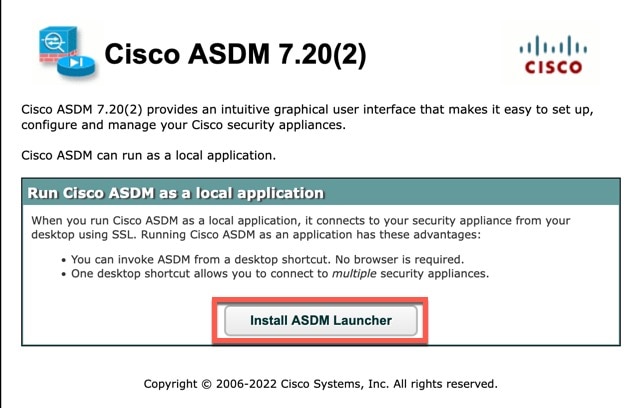
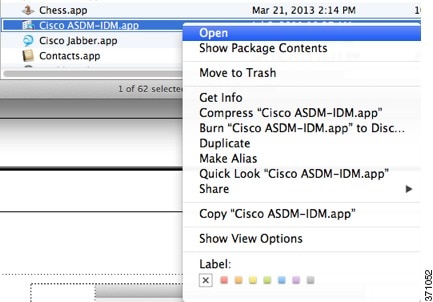
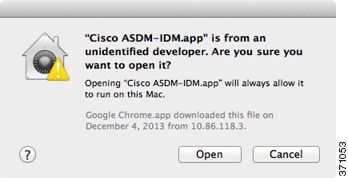
 Feedback
Feedback